The Crucial m4 SSDs have been on the market nine months, and have built a good track record around mainstream value and reliability in that time. Crucial has been great about continuing to enhance their line of m4 SSDs with firmware updates, a key advantage thanks to using their own NAND and extensive engineering team. While one update has been for an unforeseen stability problem, another has tuned the m4 for even better performance across all capacities as seen in our updated 256GB m4 review. The overall quality of the drives and support from Crucial then make the m4 platform a good candidate for RAID use, for those looking to stretch out impressive performance with a reliable backbone.
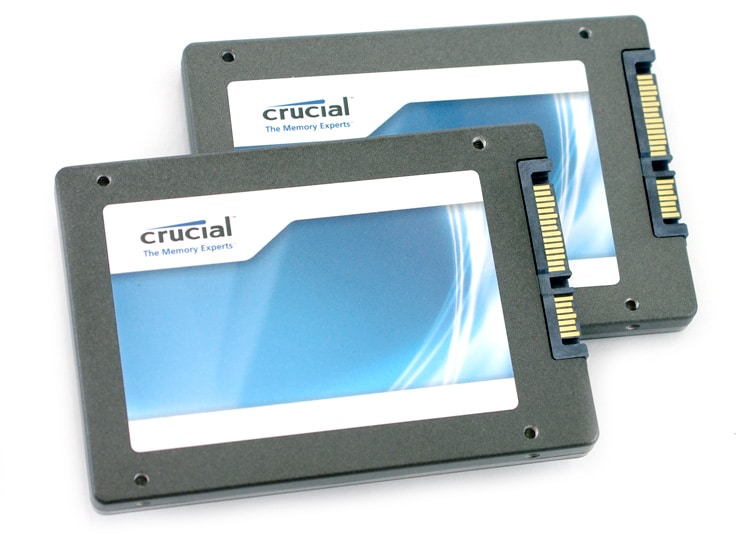
The reasons for using at least a pair of SSDs in RAID0 are many; the performance gains are generally impressive and at times, the cost of two lower capacity drives is less than a single higher capacity drive. In this review, we are taking a pair of 256GB Crucial m4 SSDs with the latest 0309 firmware in a RAID0 configuration.
Crucial m4 SSD (256GB) Specs
- Formatted Capacity – 238.47GB
- SATA 6Gb/s interface
- Sustained Sequential Read: Up to 500 MB/s
- Sustained Sequential Write: Up to 95 MB/s
- 4KB Random Read: Up to 45,000 IOPS
- 4KB Random Write: Up to 20,000 IOPS
- Marvell 88SS9174-BLD2 processor
- 415MB/s read, 260MB/s write
- 25nm Micron MLC NAND
- 72TBW
- 3 year warranty
- 2.5″ form factor
Synthetic Benchmarks
After we reviewed the latest 0009 firmware on the Crucial m4, we saw exceptionally strong sequential read performance nearing 500MB/s with write speeds around 243MB/s. Moving into a RAID0 setup we wanted to see how performance would ramp up, especially in a mixed-workload environment where the latest firmware scaled performance down in certain ways. Our testing environment consists of a Lenovo ThinkServer RD240 using a LSI MegaRAID 9260-8i for RAID. Our standard RAID configuration includes a 128K stripe size, write back enabled, read ahead, as well as drive cache enabled.
Our first test looks at straight line performance with a 2MB sequential transfer test using IOMeter.
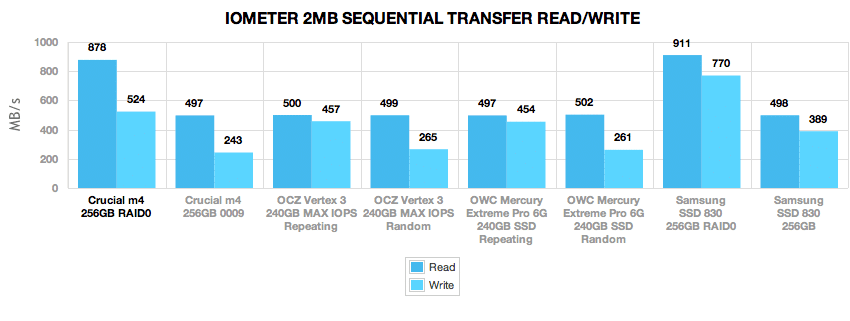
Performance in RAID0 doubled the more than doubled the sequential write speeds from 243MB/s to 524MB/s, and lifted read speeds from 497MB/s to 878MB/s.
Next we look at random access speed with the same 2MB transfer size in IOMeter.
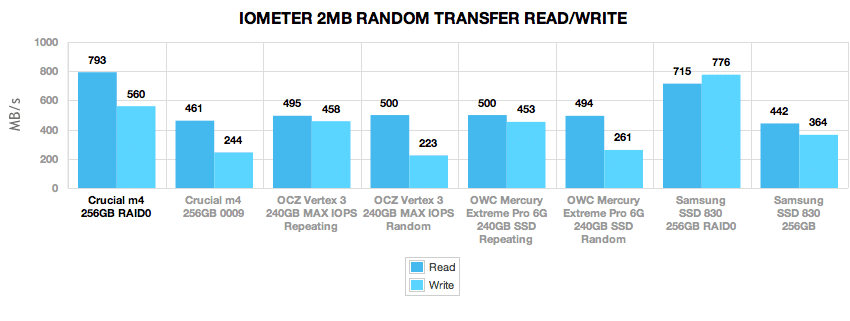
Write speeds still had more than double the performance in the 2MB random transfer test, going from 244MB/s to 560MB/s. Read speeds jumped from 461MB/s to 793MB/s.
Our next group of tests switches to smaller 4K transfers, which are the bread and butter of flash storage. With no moving parts to slow them down, SSDs are able to blow hard drives out of the water in random access speeds. One should also note that in many RAID configurations, strip size can and will have an impact on performance.
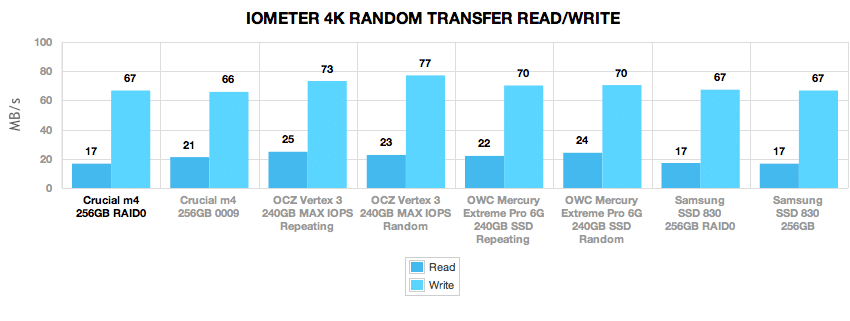
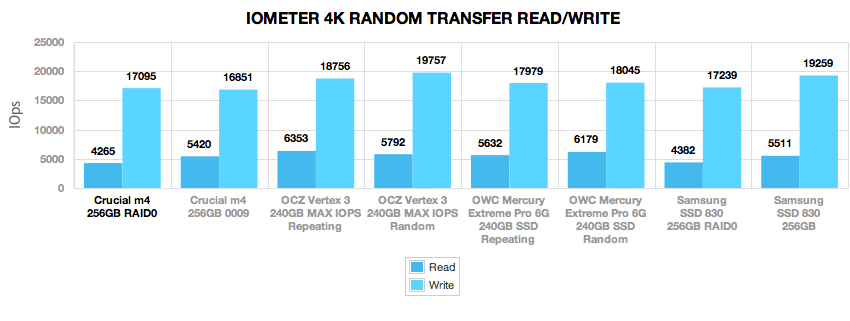
At a queue depth of 1, the performance of the Crucial m4 in RAID0 was slightly higher in write speed but slower in 4K random read speed.
Looking at expanded queue depths, the m4 SSD saw a huge boost in performance, scaling up from 47,100 IOPS as a single drive to 90,300 IOPS in RAID0
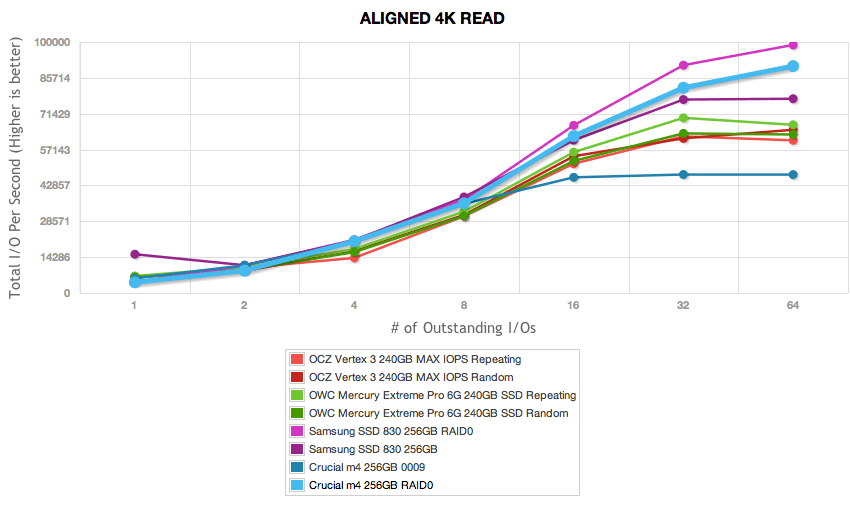
In the write test the performance stayed level, topping at roughly 27,675 IOPS at a queue depth of 32.
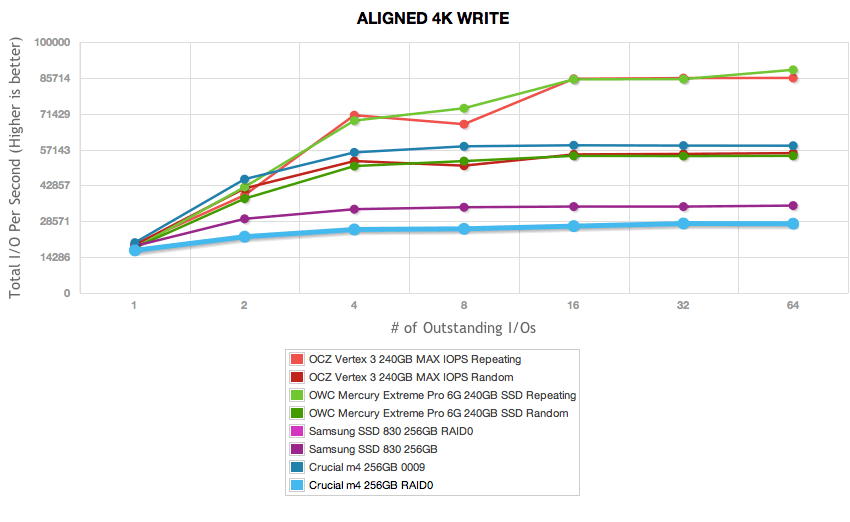
Given the weaker 4K write RAID0 speeds at a queue depth of 1, it wasn’t a huge surprise to see the drive come in weaker in our latency test compared to a single drive. It had an average latency of 0.06ms with a peak latency of just 1.26ms.
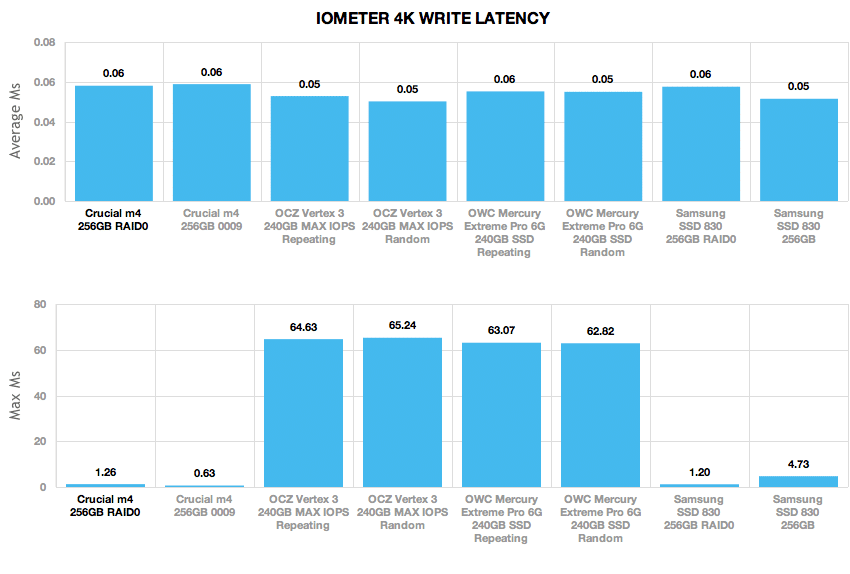
In CrystalDiskMark we saw substantial improvements in large sequential and random transfers. 4K random transfer speeds remained largely flat, with a small bump in write performance from 58MB/s average to 67MB/s in RAID0.
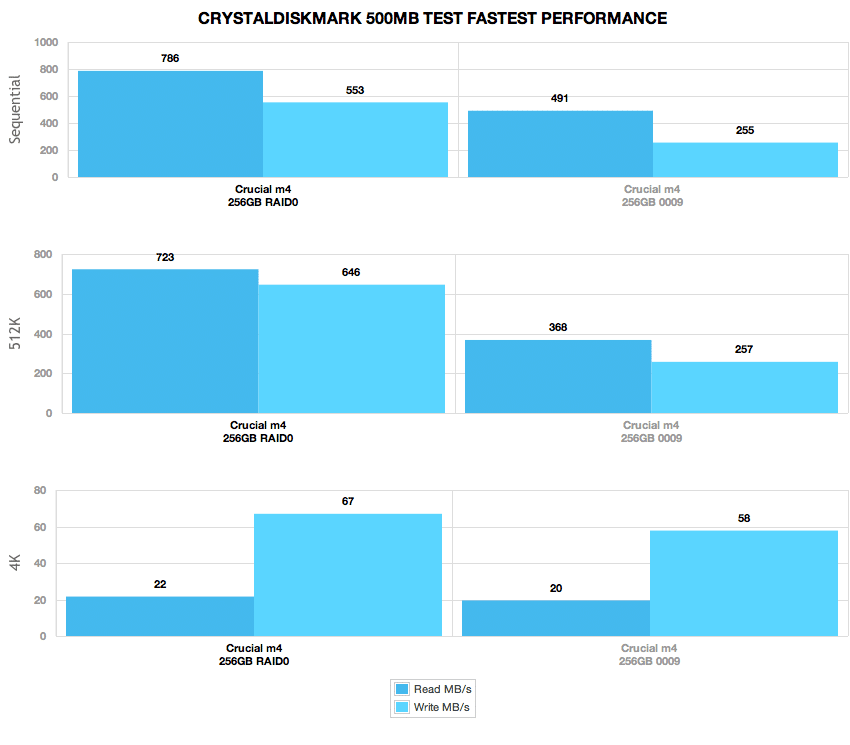
Our last section of synthetic benchmarks looks at the performance of the Crucial m4 SSD in a mixed workload business environment. The m4 in RAID0 stayed middle of the pack, offering a big boost over a single m4 in most areas, with strengths showing in areas with heavy read activity.
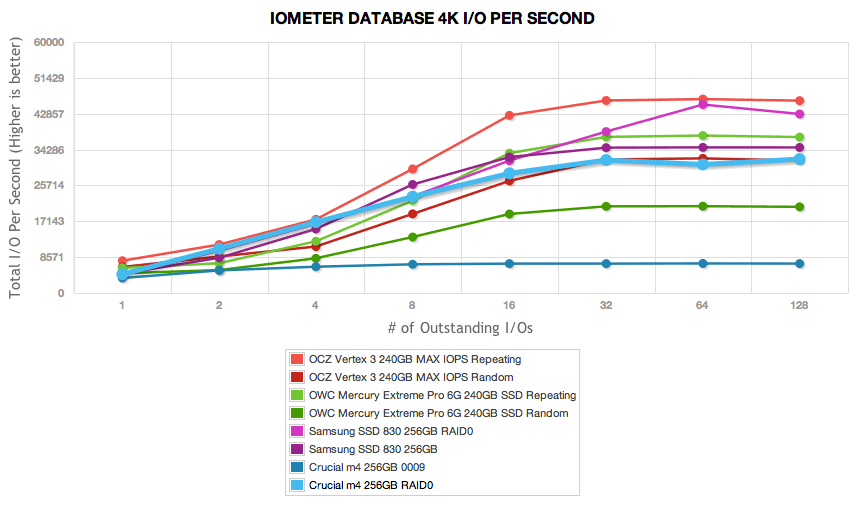
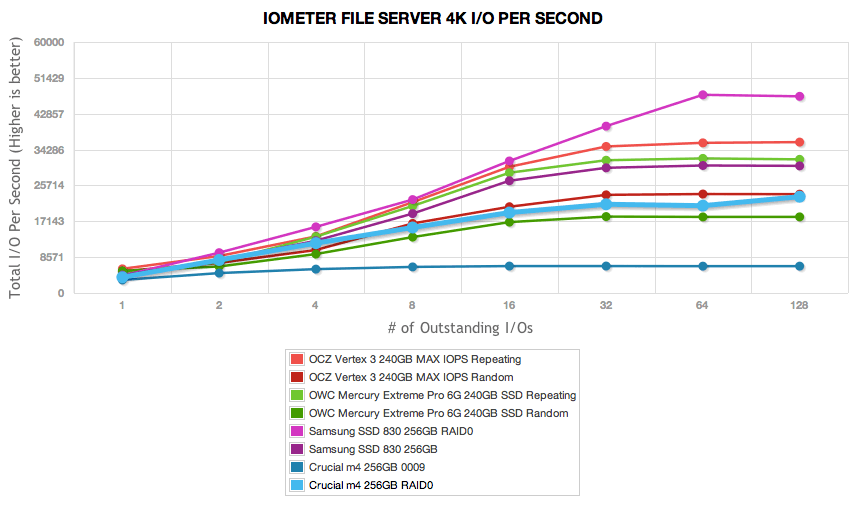
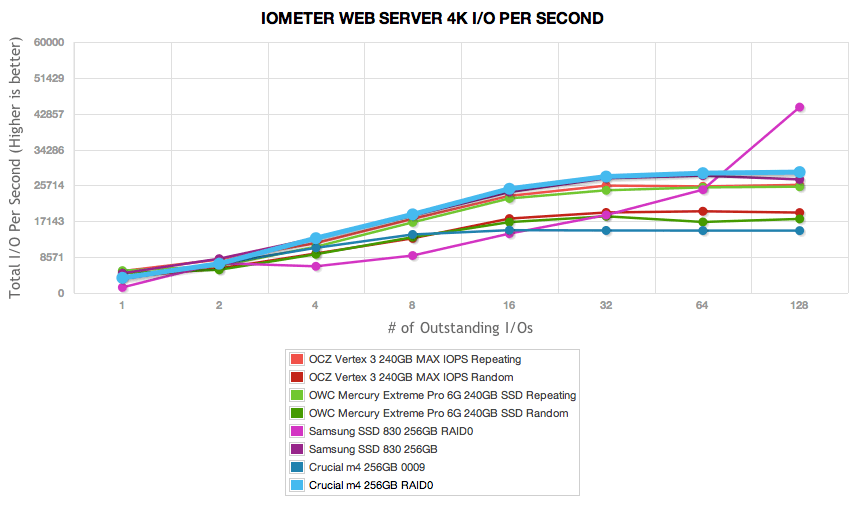
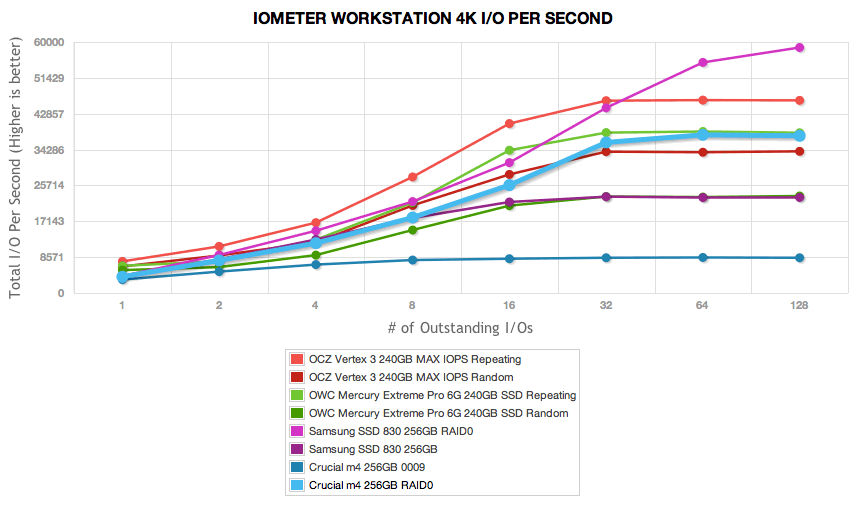
Real World Benchmarks
If you are new to StorageReview, one thing we try to focus on is how any given drive might perform under real-world conditions. For the average user, trying to translate high random 4K write speeds into an everyday situation is difficult. It also doesn’t make sense to assume that a drive with very high sequential speeds is going to perform great in the real-world if it can’t cope with mixed random activity. To really see how drives perform under normal work-loads you need to record the exact traffic being passed to and from the device, and then use that to compare drives against one another. For this reason we turned to our StorageMark 2010 traces which include HTPC, Productivity, and Gaming scenarios to help our readers find out how well a drive might perform under their conditions.
The first real-life test is our HTPC scenario. In this test we include: playing one 720P HD movie in Media Player Classic, one 480P SD movie playing in VLC, three movies downloading simultaneously through iTunes, and one 1080i HDTV stream being recorded through Windows Media Center over a 15 minute period. Higher IOps and MB/s rates with lower latency times are preferred. In this trace we recorded 2,986MB being written to the drive and 1,924MB being read.
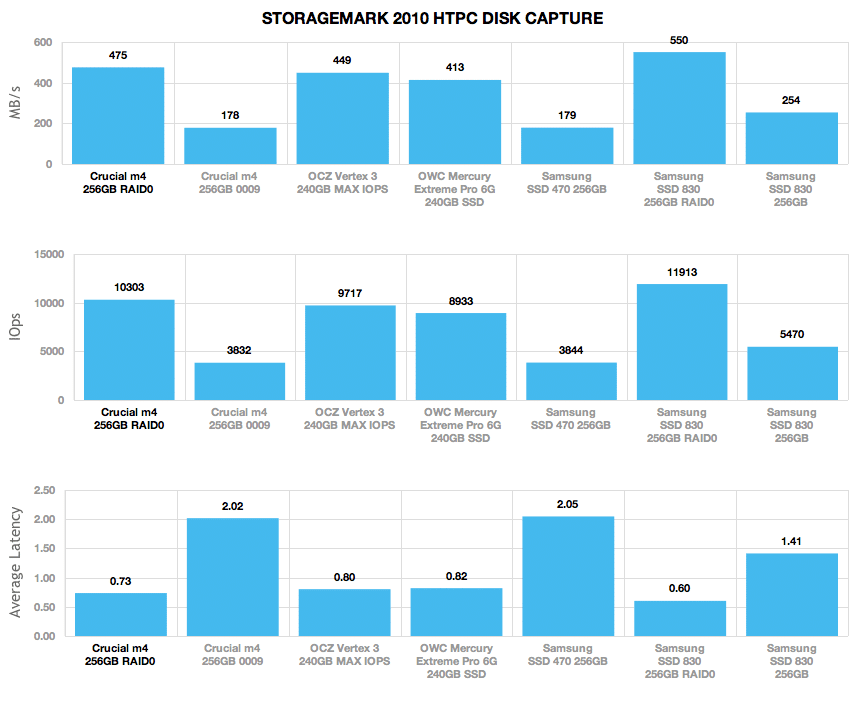
In our HTPC trace, performance jumped from an average speed of 178MB/s from a single m4 SSD to 475MB/s with the m4 SSDs in RAID0.
Our second real-life test covers disk activity in a productivity scenario. For all intents and purposes this test shows drive performance under normal daily activity for most users. This test includes: a three hour period operating in an office productivity environment with 32-bit Vista running Outlook 2007 connected to an Exchange server, web browsing using Chrome and IE8, editing files within Office 2007, viewing PDFs in Adobe Reader, and an hour of local music playback with two hours of additional online music via Pandora. In this trace we recorded 4,830MB being written to the drive and 2,758MB being read.
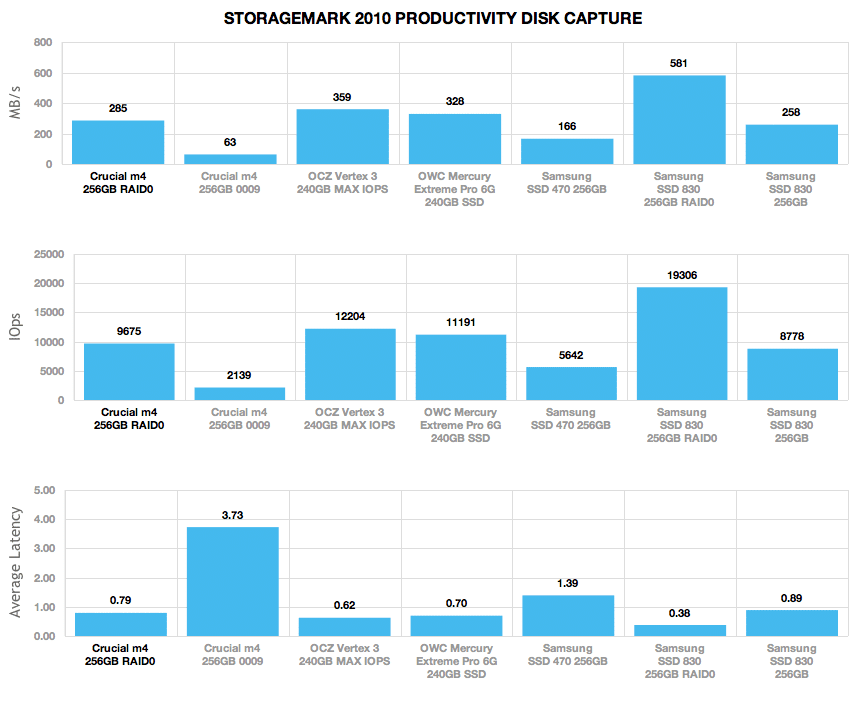
In our productivity trace where the single m4 SSD showed a great deal of weakness, we saw speeds spike from 63MB/s average to 285MB/s.
Our third real-life test covers disk activity in a gaming environment. Unlike the HTPC or Productivity trace, this one relies heavily on the read performance of a drive. To give a simple breakdown of read/write percentages, the HTPC test is 64% write, 36% read, the Productivity test is 59% write and 41% read, while the gaming trace is 6% write and 94% read. The test consists of a Windows 7 Ultimate 64-bit system pre-configured with Steam, with Grand Theft Auto 4, Left 4 Dead 2, and Mass Effect 2 already downloaded and installed. The trace captures the heavy read activity of each game loading from the start, as well as textures as the game progresses. In this trace we recorded 426MB being written to the drive and 7,235MB being read.
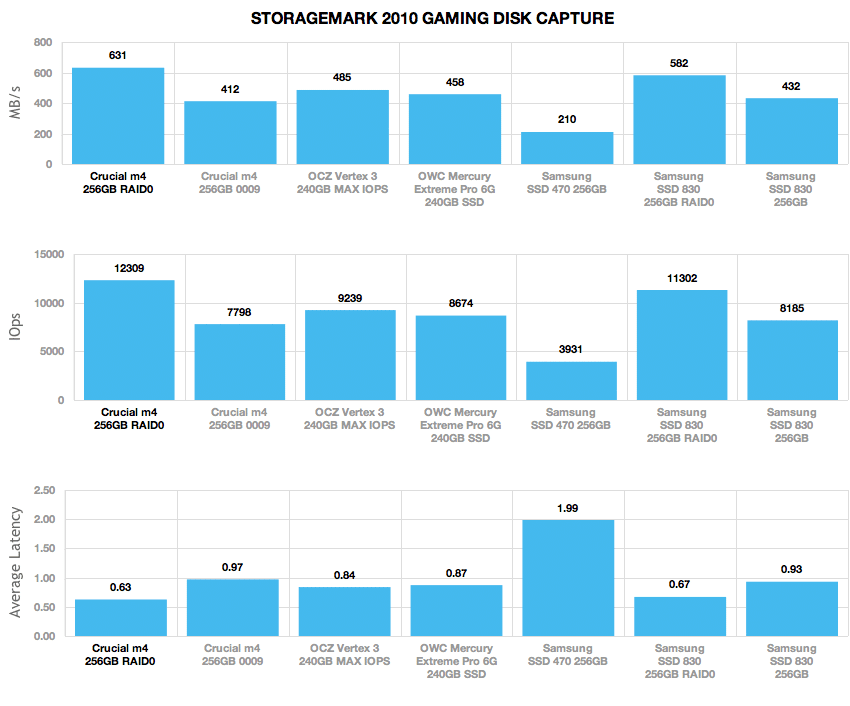
In the read-heavy gaming trace the Crucial m4 SSD in RAID0 led the pack with an average speed of 631MB/s compared to just 412MB/s from a single m4 SSD.
Conclusion
Performance of the Crucial m4 SSD when paired up in RAID0 was impressive, especially in areas with heavy read activity. In straight line performance the m4 in RAID0 measured 878MB/s read and 524MB/s write, more than doubling the previous write speeds. The areas where the Crucial m4 in RAID0 really shined was in our Gaming trace, outpacing the Samsung SSD 830 in RAID0 with an average speed of 631MB/s.
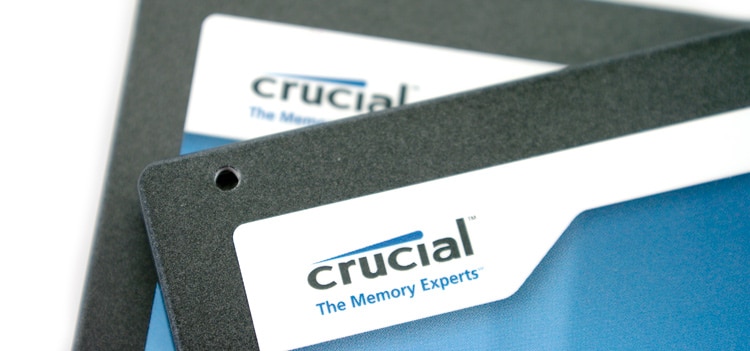
Across the board, especially in mixed-workloads we saw gains of close to, if not more than double. Looking at specific tests like the HTPC trace, speeds jumped from 178MB/s from a single m4 SSD to 475MB when in RAID0. Gains weren’t double in all areas though, with the m4 trading wins with the Samsung SSD 830 in various tests, as well as carrying over some of the weak server profile performance that we saw after the 0009 firmware update. Overall though, the m4 worked well in RAID0 and with Crucial’s quality and ongoing firmware support, along with the stable Marvell controller, the m4 SSD should be a long-lasting performer in both single drive and RAID0 modes.
Pros
- Read speeds just under 900MB/s in RAID0
- Random 4K read speeds topping 90,000 IOPS
- Very strong incompressible write speeds
Cons
- Weak-mixed workload performance still carries over from the 0009 firmware
Bottom Line
For enthusiasts looking to squeeze out even more performance from reliable SSD like the Marvell-powered Crucial m4, going to RAID0 can make sense where you need substantially higher read and write speeds.




 Amazon
Amazon